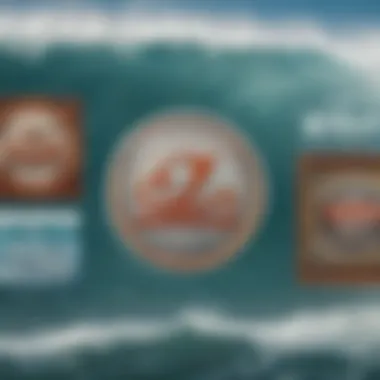Exploring the Evolution of Surf Brand Logos


Intro
The world of surf brand logos is not merely about visual appeal; it reflects a unique amalgamation of culture, community, and identity. Each logo tells a story that resonates with surfers and enthusiasts alike, carrying with it a history and a set of values. As one dives deeper into understanding these logos, the insights uncovered reveal how they embody the spirit of surf culture and influence perception in the watersport industry.
From simple designs to intricate artworks, surf logos are gateways into the brand's philosophy. Companies such as Quiksilver, Billabong, and Hurley have managed to carve distinctive identities through their logos, establishing lasting impressions that go beyond the product itself. This article aims to explore this intricate tapestry of branding, focusing on how these logos have evolved over time and their broader implications within surf culture.
Essential Techniques
Design Elements in Surf Logos
The craftsmanship behind surf logos goes beyond mere aesthetics. Designers often draw on a series of key elements:
- Shapes: Curves and waves can symbolize movement and energy, essential traits associated with surfing.
- Colors: Bright colors might represent the vibrant lifestyle of surf culture, while muted tones can convey serenity and nature.
- Typography: A logo’s font can evoke a feeling of youthfulness or tradition, impacting how the brand is perceived.
Each of these elements serves not just a functional purpose but also resonates on an emotional level with the target audience. They allow the viewer to connect with the brand in a way that feels authentic and meaningful.
"A logo is not just a symbol; it’s a beacon for community and values. It draws people in and creates connections."
The Evolution of Surf Brand Logos
The landscape of surf brand logos has changed dramatically since the early days of surfing. From the basic designs rooted in beach aesthetics, logos have grown to encapsulate an entire lifestyle.
- 80s and 90s: Influenced by pop culture, logos became bolder and more graphic, often incorporating iconic imagery related to surf culture.
- 2000s Onwards: A shift toward minimalism took place, with brands opting for cleaner and more simplified logos while maintaining brand essence.
This evolution aligns with broader design trends while establishing a timeless quality that appeals to both longtime surfers and newcomers.
Gear Recommendations
Iconic Logos and Their Gear
The logos of well-known surf brands are often tied to specific equipment that shapes the surfing experience. Brands like Rip Curl and O’Neill have logos that evoke a sense of adventure and quality, often represented in their wetsuits and surfboards. When selecting gear, consider:
- Quality: Look for brands known for durable, high-performance gear.
- Design: Many surfboards come with vibrant, eye-catching logos that are more than just labels; they can reflect a certain design trend or cultural era.
Choosing the Right Gear
Finding the right equipment is crucial for enhancing one’s surfing experience. A surfboard�’s design might affect performance in the water, while clothing with a logo might represent community belonging:
- Surfboards: Check out the latest designs from brands like Channel Islands or Firewire. Seek boards that match your skill level and style.
- Wetsuits: Brands like Xcel and Patagonia create suits that ensure comfort in various water temperatures, blending functionality with stylish logos.
As one navigates through the surf industry, understanding the significance of logos can enhance both the gear selection process and the overall surfing experience.
In grappling with these elements, it becomes clear that surf brand logos are more than just images; they are encapsulations of identity and community, significantly impacting how surfers connect with their environment and each other.
Understanding Surf Brand Logos
In the realm of surfing, brand logos are not merely aesthetic choices; they symbolize the spirit, culture, and values inherent to the sport. To fathom the significance of surf brand logos, it is crucial not only to recognize what they represent but also to analyze how they resonate with both enthusiasts and those outside the surf community. Surf brands have a unique way of merging visual art with functional lifestyle elements, creating identities that can make or break their market presence.
Definition and Importance
Surf brand logos serve as visual representations of the values and mission of the brand. They encapsulate what the company stands for, transcending mere graphics. For instance, a logo might evoke feelings of freedom, adventure, or connection to nature. The importance of these logos lies in their ability to forge immediate emotional connections. When surfers wear a brand’s logo, they aren't just showcasing an image; they are embracing a lifestyle and community.
- Brand Recognition: An effective logo fosters instant recognition. Think of how iconic logos like those of Quiksilver or Billabong can trigger nostalgia or excitement among surfers. This is the power of recognition—when consumers can recall a brand merely by its visuals, it can lead to increased loyalty.
- Consumer Trust: A well-designed logo also conveys professionalism, instilling trust. If a logo looks haphazard or poorly designed, it can create doubt in potential customers.
- Cultural Relevance: As cultural icons, logos can reflect broader trends and shifts in societal values, such as sustainability. Many surf brands today focus on eco-friendly materials, and their logos often incorporate elements that signify this commitment.
Historical Context
Delving into the historical context of surf brand logos reveals how these symbols have evolved alongside the sport itself. In the early days, logos were simple and often hand-drawn. As surfing gained popularity in the 1960s and 1970s, logos began to incorporate vibrant colors and graphics that captured the exhilarating essence of the ocean and waves.
During this time, brands such as Vans and O’Neill emerged, with logos that visually spoke to the adventurous spirit of surfers. Their designs weren't just marketing tools; they were expressions of a lifestyle. Having influence from the counterculture movements, these logos often represented rebellion and freedom.
Now, moving into the 21st century, advancements in digital design have allowed for sharper, bolder logos that can adapt to various platforms, from merchandise to social media. The ability to adjust a logo for online visibility is vital, as many consumers interact with brands on diverse digital mediums.
Role in Brand Identity
Logos play a pivotal role in establishing and maintaining brand identity. They are not merely decorative elements but integral parts of how a company communicates its mission and ethos.


- Visual Storytelling: A logo can tell a narrative. For example, a wave symbol can represent the brand’s dedication to the ocean, while a mountain icon might reflect adventures beyond surfing, catering to a broader outdoor lifestyle.
- Emotional Connection: Logos are often charged with emotional significance. A well-crafted logo can evoke memories of great waves, sun-soaked beaches, and camaraderie amongst the surfing community.
- Differentiation: In a saturated market, an effective logo helps distinguish one brand from another. Brands like Rip Curl have cultivated their identity through innovative logos, each iteration telling a story of their growth and dedication.
In summary, understanding surf brand logos entails recognizing their definition, historical evolution, and pivotal role in brand identity. These visual emblems bridge the gap between the consumer and the surf culture, making them indispensable in today's competitive landscape.
"A logo is not just a design but a doorway into a brand's identity and its story."
The impact of logos cannot be understated—they are the embodiment of the surf culture, instilling a sense of belonging and purpose among enthusiasts.
Elements of Effective Logo Design
In the competitive landscape of the surf industry, a brand's logo is its face. It's the first thing potential customers see and serves as a powerful communication tool. The logo not only differentiates the brand but also encapsulates its essence, values, and aspirations. As such, the elements that compose a successful logo—colors, typography, and iconography—carry significant weight. Understanding each component and leveraging them appropriately can elevate a surf brand's identity and market presence.
Color Psychology
Color is not just a visual experience; it's an intrinsic part of human emotion and perception. In the context of surf brand logos, colors can evoke the feelings associated with the ocean, freedom, and adventure. For example, blue often symbolizes tranquility and depth, resonating well with the aquatic theme, while bright yellows and oranges might reflect energetic, sunny vibes associated with a beach lifestyle. Making the right color choices can profoundly affect a brand's image and consumer connection.
When designing a logo, consider the following aspects of color psychology:
- Brand Attributes: Map colors to the qualities you want to convey. Would you like to represent reliability? Opt for deep, earthy tones. Seeking vibrancy? Bright hues could do the trick.
- Target Audience: Different demographics respond to colors in unique ways. Youthful consumers might prefer bolder, trendier colors, while a more mature audience could find muted tones more appealing.
- Cultural Connotations: Colors have varied meanings in different cultures. Understanding local perceptions can guide choices that resonate well in specific markets.
"Every logo tells a story, and color is its language. Choose wisely."
Typography Choices
Typography can set the tone of a brand. The font selected for a logo can express seriousness, playfulness, or modernity. In the surf world, it’s essential to align typography with the brand’s ethos. Heavy, bold fonts may convey strength and durability, a characteristic embraced by lifelong surfers. In contrast, fluid, cursive fonts might appeal more to a lifestyle vibe, emphasizing ease and relaxation.
Key considerations when selecting typography include:
- Readability: A logo should be easily recognizable from afar. Avoid overly ornate scripts that may confuse potential customers.
- Brand Alignment: The style of the typography should align with the Brand Identity. A sleek modern font could fit a high-tech surfboard brand, while a hand-drawn typeface might suit a brand with a back-to-nature ethos.
- Flexibility: Consider how the typeface will appear in different sizes and formats. It should be versatile enough to look great on everything from a surfboard to a business card.
Iconography
Icons in logos are visual symbols that can convey complex ideas quickly and effectively. In surf branding, the right icon can evoke a sense of adventure, community, or natural beauty—elements deeply embedded in the surfing culture. Icons can range from minimalist ocean waves to elaborate designs incorporating elements like boards, sea creatures, and sun imagery.
When crafting iconic visuals, consider these factors:
- Simplicity: A simple design often yields better brand recall and adaptability. Complicated logos can become muddied or lost in translation across different media.
- Relevance: Icons should reflect the brand's heritage or guiding principles, fostering a genuine connection to its audience. An environmentally-conscious brand may incorporate elements emphasizing sustainability, like leaves or recycling symbols.
- Memorability: Effective icons have a unique quality that catches the eye and stays in consumers' minds. Think of the easily recognizable shark logo of Rip Curl—it's simple yet powerful.
Case Studies of Notable Surf Brands
Exploring case studies of notable surf brands provides invaluable insights into how logos not only serve as visual identifiers but also carry significant narratives about the brands themselves. Each surf brand stands as a testament to the merging of art and function, presenting unique lessons in market positioning, brand voice, and cultural resonance. By critically analyzing these brands, we learn about the subtleties that transform a simple logo into a symbol of lifestyle and community.
Brand Analysis: Quiksilver
Quiksilver, founded in 1969, quickly carved a niche in the surfing market with its bold, dynamic logo featuring a distinctive mountain and wave symbol. This logo is not just an aesthetic choice; it represents the dual nature of surfing enthusiasts who traverse both the sea and land. Its color palette embodies the ocean's blue and the earthy tones of the mountains, creating a cohesive identity. The sleek font complements the logo's visual appeal, suggesting energy and movement.
In a world that often prioritizes speed and excitement, Quiksilver’s branding effectively communicates a lifestyle that embraces adventure. The recognition of this brand is so widespread that it often transcends the realm of surfing, becoming a staple in casual wear and lifestyle products, illustrating how a well-designed logo can extend brand reach beyond its original market.
Brand Analysis: Billabong
Billabong’s logo features a unique wave design that elegantly speaks to its core audience—those who live and breathe the surfing lifestyle. Established in 1973, the logo evokes a sense of freedom and motion, aligning perfectly with the brand’s ethos. The simplicity of the wave icon captures the essence of surf culture, emphasizing both elegance and raw power.
The brand has worked diligently to maintain relevance over the decades. Through clever marketing strategies and sustainable practices, Billabong manages to attract a conscientious consumer. The logo's aesthetic plays into this notion, as it is often featured on eco-friendly products, tying brand identity to environmental consciousness.
Brand Analysis: Rip Curl
Rip Curl, known for its surfing apparel and equipment, features a logo that involves a uniquely stylized representation of a wave curling back on itself. This imagery closely reflects the act of surfing that the brand both supports and celebrates. Founded in 1969, Rip Curl has consistently innovated while staying true to its roots, and the logo has evolved gracefully along with the brand.
The logo also incorporates a dynamic font that mirrors the shape and energy of surf culture, making it instantly recognizable. Rip Curl has successfully intertwined its identity with the surfing community by forming a deep connection with athletes and enthusiasts. This opens up pathways for local engagement, which is vital in a market where genuine connections can set companies apart.
Brand Analysis: Volcom
Founded in 1991, Volcom’s logo—a bold, stylized "V" within a diamond—has grown to symbolize rebellion and creativity in action sports. The logo's geometric simplicity and sharp angles communicate a sense of attitude and youthfulness, which resonates well with skateboarders and surfers alike.
Volcom's brand message emphasizes authenticity and self-expression, which is reflected in its logo and merchandise designs. The brand integrates art and culture seamlessly into its identity, reflecting the diverse interests of its youthful demographic. The visually striking logo contributes to a community feeling, where individuals can feel part of a larger movement that values creativity and edge.
"Logos are the fingerprints of a brand—unique, defining, and often irreplaceable. They carry the stories and values of a community."
Analyzing these prominent surf brands showcases the various approaches to branding within the surf industry. Each logo serves as a narrative tool that articulates the brand's philosophy while forging connections with consumers. Understanding these elements not only benefits brands but also enriches the consumers' experience and connection to the brand.
The Cultural Impact of Surf Logos
The world of surf brands is more than just about the waves; it's a tapestry woven with identity, culture, and values, all encapsulated within their logos. Surf logos serve as beacons, guiding brand recognition and loyalty among enthusiasts. Each logo tells a story, revealing connections to the ocean, lifestyle, and community that go beyond simple aesthetics.
Conveying Values and Lifestyle
Surf logos often convey deep-rooted values, resonating with a lifestyle that emphasizes freedom, adventure, and environmental consciousness. For instance, consider the logo of Patagonia—its design is not just a visual mark; it projects a commitment to sustainability and ethical practices conjoined with the thrill of outdoor adventures. This approach attracts consumers who value authenticity and want their purchases to reflect their principles.
In the realm of surfing, simplicity is key. A logo like that of Billabong, featuring a stylized wave, embodies the thrill of riding waves. Here, the logo not only represents a product but also integrates the essence of surf culture. When individuals choose apparel or equipment adorned with such logos, they are not just making a fashion statement; they are showcasing a lifestyle that is intertwined with the sea. This connection supports a sense of belonging to an aspirational community that values adventure.
Influence on Youth Culture
Surf logos wield tremendous influence on youth culture, shaping not only preferences in fashion but also the mentality surrounding freedom and rebellion. Think about the iconic Quiksilver logo, recognized everywhere. It's more than just a brand; it's a badge of belonging for generations of young surfers who aspire to be part of something bigger—a lifestyle steeped in acceptance, thrill, and the undulating rhythm of ocean waves.
Additionally, these logos create a collective identity among youth. They spark dialogue and connection, often driving trends that go viral in quickly changing social media landscapes. Young people frequently gravitate toward brands that not only stand for premium quality but also resonate with their ideals. The logos serve as a symbol that they can rally around, fostering cultural movements that address both individual and community aspirations.
Community and Belonging
The connection between surf logos and community cannot be overstated. Logos function as a tool for storytelling and connection among surfers. They are the conversation starters, igniting camaraderie in lineups and at surf competitions. When someone sees a logo that they identify with, it often sparks recognition and friendship, fostering a sense of belonging.
Logos like those from Rip Curl represent more than just a brand; they embody a shared passion for surfing and a commitment to preserving the surf culture. This fosters strong ties within communities, whether in local surf shops or on beaches around the world. The notion of community amplifies during competitions and surf festivals, where logos unite competitors and spectators alike.
"A logo is not just a design; it’s a symbol of shared adventure, a marker of identity, and a point of connection for like-minded individuals."
In essence, surf logos not only represent brands but also encapsulate values that resonate with individuals. They connect those who seek adventure and highlight a culture rich in stories and relationships.
By recognizing the cultural impact of surf logos, we can better appreciate their role in uniting a diverse community through shared ideals and experiences.
Trends in Surf Brand Logo Design
In examining surf brand logos, it's crucial to grasp the trends that shape their design. These trends reflect not only what’s aesthetic, but also what resonates with consumers, especially in an ever-evolving market.
Brand logos are more than mere symbols; they encapsulate a brand's identity, philosophy, and the lifestyle associated with it. Given the surf culture's dynamic nature, logos tend to follow the waves—what’s 'in' today might not be so hot tomorrow. To keep up with this, surf brands must consistently adapt and innovate, making awareness of current trends vital for success.
Minimalism and Simplicity
The trend towards minimalism aligns with today’s fast-paced lifestyle. In a world flooded with information, a simple design can cut through the noise.
More brands are opting for clean lines and fewer colors. This doesn’t just make logos more recognizable; it also enhances adaptability across various media, from business cards to billboards. Consider the Hurley logo, where the use of a simple checkmark can evoke feelings of motion and surfing without being overly complex.
- Minimalist logos often possess a timeless quality, shedding the need for frequent redesigns.
- Additionally, they resonate well on social media platforms, where clear visuals grab attention quickly.
In the age of digital branding, a logo as straightforward as Banzai’s keeps it fresh and easy to remember.
Retro Influences
There’s also been a resurgence of retro aesthetics in surf brand logo design. Finding inspiration from the past allows brands to create a sense of nostalgia, which can be a powerful emotional hook.
Surfing, with its rich history, provides fertile ground for retro influences. Logos that draw on styles from the 70s or 80s can evoke a sense of authenticity. Take Vissla for example. Their branding often features vibrant colors and traditional fonts reminiscent of surfing’s golden ages. The key here is to not just recycle old styles, but to do so in a way that feels fresh and unique.
Here are some benefits of embracing retro influences:
- Builds a connection with older generations while attracting new ones.
- Evokes authenticity, an important aspect of surf culture.
Sustainability and Ethical Branding
As awareness around sustainability continues to grow, there's a noticeable shift toward eco-friendly branding in the surf industry. Modern consumers are increasingly considering the ethical implications of their purchases. As such, many brands are emphasizing their commitment to sustainable practices right into their logo design.
For instance, Patagonia incorporates elements that reflect their ecological ethos. Their logo doesn’t just represent their products; it also symbolizes a commitment to environmental responsibility, which resonates strongly with environmentally conscious consumers.
- Sustainable logos often utilize earthy tones and natural images, aligning with the values of today's consumers.
- Inclusion of symbols related to nature can enhance a brand's appeal while underlining their commitment to sustainability.
Logos are not just elements of branding; they are storytellers of the brand's journey, values, and future aspirations.
In a world where consumers demand more transparency, surf brands tapping into sustainability can gain a competitive edge and foster community loyalty.


Challenges in Logo Design for Surf Brands
Designing logos for surf brands is no easy feat. It’s a balancing act where one has to juggle authenticity, trends, and global appeal. Striking the right chord can mean the difference between a logo that resonates deeply with surfers and one that ends up collecting dust. The surf industry's unique culture and market demands require brands to be sharp and in tune with their audience.
This section explores the key challenges faced by designers when creating surf brand logos, helping to unpack why certain logos stand the test of time and why others flounder in the water.
Maintaining Authenticity in Design
Brand authenticity is the name of the game in the surf world. Surfers can smell inauthenticity a mile away; they're picky about what they support. This calls brands to stay true to their roots and convey a message that reflects the true spirit of surfing culture.
- Intrinsically Tied to Values: Logos must embody the values of the brand, whether it’s freedom, adventure, or a love for the ocean. For instance, having a logo that reflects environmental consciousness can resonate well with eco-aware surfers.
- Local Influence: Many successful logos draw inspiration from local culture, often infused with the spirit of iconic surf locations like Hawaii or California. This local touch adds layers of meaning that globalized designs might lack.
- Avoiding Commercialism: If a logo feels overly commercial or detached from the lifestyle, it risks alienating its base. Authenticity in branding is akin to showing up as your true self—people respond better when they feel a connection.
Balancing Trends and Timelessness
Another pivotal challenge is navigating the waters of trends while also achieving timelessness. The surf scene is constantly evolving; what’s hot one season might go cold the next. Therefore, surfing brands need logos that can not only catch the eye today but also retain relevance over time.
- Trendy Yet Classic: Integrating contemporary design aesthetics without losing the essence can be tricky. Designers often need to find a middle ground—think of brands like Vans that maintain their classic feel while also embracing modern twists.
- Fluid Adaptability: Classic logos have a way of adapting well to changes, meaning a surf logo designed with versatility in mind is essential. Consider rip currents in the ocean; just like those waves, trends change rapidly, and rigid designs can drown out.
- Evolving Messaging: Brands also may need to adjust their logos to adapt to shifting values within the surf community. For example, logos incorporating sustainability elements became more prominent as environmental activism rose.
Adapting to Global Markets
Lastly, as surf brands penetrate international markets, the demand for culturally relevant logos grows. A logo that’s beloved in Australia might not sit well in Japan or Brazil. Adapting to these diverse markets without losing brand identity poses a significant challenge.
- Cultural Sensitivity: Designers must be keenly aware of cultural nuances to avoid misinterpretation. A symbolic element loved in one culture might carry a negative connotation in another.
- Global Branding: Effective logos work on a universal branding level yet retain local appeal. Brands like Billabong have made strides in understanding local contexts while keeping their core identity intact.
- Translating Values: As brands globalize, they need to communicate their values clearly and effectively, ensuring that the emotional resonance remains intact across varied cultural landscapes.
Navigating the global surf market requires brands to think critically about logo design; it's about striking that perfect balance between appealing to various audiences while staying true to the brand's essence.
The Future of Surf Brand Logos
As we gaze into the horizon of surf brand logos, the landscape is changing at breakneck speed. The intricate interplay between technology, culture, and consumer behavior is leading surf brands to innovate in ways that were unthinkable just a decade ago. Understanding these trends is crucial, as they define how surf brands will establish their identities, connect with audiences, and ultimately carve out their niches in a competitive marketplace.
Digital Transformation and Branding
The advent of the digital era has completely reshaped branding strategies, and surf brands are no exception. In previous years, logos were often designed for physical presence—on surfboards, apparel, and merchandise. Now, with social media and e-commerce platforms dominating consumer interactions, logos need to be adaptable. A surf brand logo must look sharp on a tiny mobile screen just as much as it does on a billboard.
Moreover, digital branding brings in the notion of content creation. Logos aren’t merely static images; they become part of a larger storytelling experience. Brands like O’Neill utilize their logos across engaging content that communicates their values and lifestyle, effectively turning their logo into a recognizable badge of identity in the digital sea.
"In a world where consumers are bombarded with options, a logo must do more than catch the eye; it must weave a narrative that fosters brand loyalty and connection."
Emerging Technologies in Design
Technological advancements are impacting the design aspect of surf brand logos in fascinating ways. Tools like augmented reality (AR) and virtual reality (VR) are starting to find their way into branding. Imagine scanning a surfboard with your phone and seeing the logo spring to life with a video of a ride, or the process of creating a logo becoming more immersive through 3D modeling. These technologies are not just gimmicks; they provide an interactive experience that can enhance consumer engagement profoundly.
In addition, machine learning is now being utilized to analyze trends in design effectiveness. By gathering data from social media engagement and sales results, brands can refine their designs with precision that was unimaginable a short while ago. Companies are beginning to realize that to stay relevant, they have to be agile, adapting their logos based on in-depth insights.
Anticipating Market Trends
The surf industry is like a wave—always changing and unpredictable. To keep up, brands must stay ahead of emerging trends and consumer values. Sustainability has moved from a niche concern to a mainstream expectation, influencing logo designs. Logos now incorporate natural elements and eco-friendly motifs, reflecting a commitment to the environment.
Furthermore, cultural shifts shape logo expectations. The modern surfer is often a digital native, seeking authenticity and relatability in brands. A logo that speaks to their lifestyle, promotes social causes, or embodies diversity resonates more with the younger generations. This shift is pushing brands to expand beyond simple aesthetics and embrace social responsibility.
As we surf into the future, surf brand logos will continue to evolve. The ways in which they intertwine with technology and the shifting cultural landscape will significantly dictate their impact. By recognizing these trends, surf brands not only enhance their visibility but also solidify their place within the hearts and minds of consumers.
The End: The Legacy of Surf Logos
Surf brand logos hold a significant place in the realm of branding and culture, especially within the dynamic world of watersports. They are not merely graphical representations; rather, they embody the spirit and identity of their respective brands. Over the years, surf logos have evolved, reflecting changes in consumer preferences, design aesthetics, and broader cultural trends. Their legacy speaks to the intricate connections that exist between branding, lifestyle, and community.
Reflecting on Brand Evolution
When contemplating the evolution of surf brand logos, one can’t ignore the historical context from which they emerged. Back in the day, logos were simpler, often depicting the essence of the sport in straightforward imagery. For instance, the early Quiksilver logo, featuring a stylized wave and mountain, was a direct homage to both surfing and snowboarding cultures. This connection is graciously represented in its designs.
As time progressed, brands began to understand that a logo was more than just a visual marker—it was a representation of values, a stance on lifestyle. Contemporary logos often showcase bold designs, intricate details, and strong color schemes that resonate with younger audiences. The shift towards minimalism also illustrates this evolution; design preferences have swung between the ornate and the simplified, playing with our perception of nostalgia, trends, and brand authenticity.
- Historical Milestones: In the early 90s, surf logos mirrored the bold, colorful styles of skate culture, while more recent trends embrace minimalistic designs, often stripped to their core elements.
- Brand Narratives: Surf logos now often carry stories—Philippe Starck’s redesign of the Rip Curl logo, influenced by sustainable practices, highlights this emerging narrative of environmental responsibility within branding.
Final Thoughts on Impact and Value
The impact and value of surf logos are evident. They serve as a visual shorthand, encapsulating entire lifestyles and cultures within their designs. A strong logo, like the one from Billabong, can evoke imagery of adventure, freedom, and rebellion against conformity. This emotional resonance played a pivotal role in establishing brand loyalty among consumers, especially youth who seek identity and belonging.
"A logo isn’t just an image; it’s a lifestyle, a statement of who you are and who you aspire to be."
Moreover, surf logos influence not just branding but also arts, fashion, and even music. The dichotomy of branding vs. authenticity becomes crucial here—consumers are increasingly discerning, often drawn to brands that align with their personal beliefs and ethics. This has brought forth a need for brands to stay true to their origins while navigating new trends and technologies. The future of surf logos, consequently, lies in a blend of authenticity, innovation, and cultural relevance.
In closing, surf brand logos encapsulate a legacy intertwined with the culture of surfing itself. They reflect not just a brand’s identity but also the evolution of an entire lifestyle—distinctive, bold, and endlessly fascinating. In understanding the past and present identity of surf logos, one can appreciate their lasting impact on the community and establish the groundwork for future trends.







